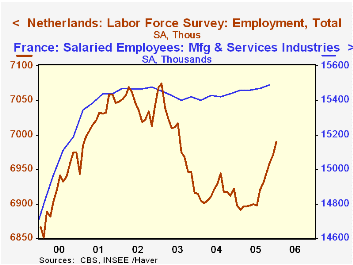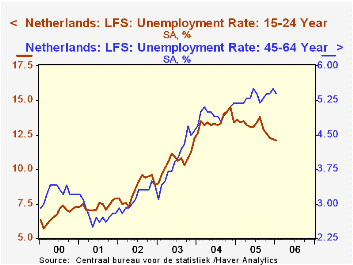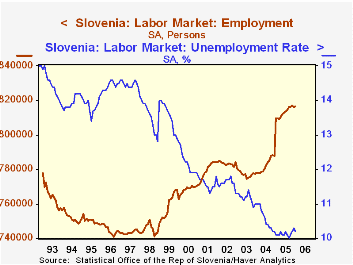 Global| Mar 16 2006
Global| Mar 16 2006France, Netherlands & Slovenia See Better Labor Market Conditions in Late 2005 and Early 2006
Summary
Yesterday here, we talked about the persistent sluggishness of employment in the UK. A few weeks ago, we had a similar discussion about Germany. While these two large European economies are seeing their labor markets struggle, those [...]

Yesterday here, we talked about the persistent sluggishness of employment in the UK. A few weeks ago, we had a similar discussion about Germany. While these two large European economies are seeing their labor markets struggle, those of some other countries are doing comparatively better.
Even in France, where riots in early November highlighted the plight of one specific segment of the labor force, employment is actually rising. The increase is not large, but in Q4, there were 20,500 new jobs in manufacturing and services industries, bringing their total to 15.489 million, a new high. As in many Western countries, the gains are all in the service sector and for France, especially in consulting and other business services. Unemployment in France has also continued to decrease, with the 9.6% rate in December and January the lowest since January 2003. The sensitive youth age range, under 25, saw an uptick in January to 22.2%, but this remains below the high last May of 22.8%.
In the Netherlands, as seen in the graph, employment fell sharply in 2003, much more so than in France, but it bounced back, particularly over the past six months. While not reaching a new peak, Dutch employment has regained more than half of its 184,000 drop between February 2003 and February 2005. Unemployment in the Netherlands is falling, with the rate down to 6.1% in January from a peak of 6.7% in February 2005. By age group, progress here is actually most noticeable in the younger segments. Unemployment for those under 25 was 12.1%, compared to 13.4% early in 2005 and as high as 14.5% in late 2004. Adult workers under 45 face only 5.6% unemployment, down slightly over the past year. Older workers, ages 45-64, also have unemployment rates in the mid-5% range, but they have remained stubbornly at that level all through the past 15 months.
In one of the smaller European nations, Slovenia, jobs have increased modestly over the last year. In January, employment was 816,600, up from an average of 813,100 for all of last year and 809,700 for January a year ago. Unemployment increased slightly this January, but it has undergone a secular decline throughout almost the entirety of Slovenia's period of independence, carrying the rate down to just over 10% from 15% in late 1992. [Note that the data collection method changed at the beginning of 2005, accounting for the sudden jump in employment then. The labor force increased by a commensurate amount so the unemployment rate was not affected.]
Thus, labor markets can behave differently even in neighboring regions and among differing demographic groups within the same region. And as we see here, big economies don't necessarily have advantages over small ones in the ability to provide job opportunities for everyone.
| Q4 2005 | Q3 2005 | Year Ago | 2005 | 2004 | 2003 | ||
|---|---|---|---|---|---|---|---|
| France: Mfg & Services Employees (Mil.) |
-- | 15.49 | 15.47 | 15.44 | 15.47 | 15.42 | 15.43 |
| Manufacturing | -- | 5.13 | 5.14 | 5.18 | 5.15 | 5.20 | 5.28 |
| Services | -- | 10.35 | 10.33 | 10.26 | 10.32 | 10.22 | 10.15 |
| Jan 2006 | Dec 2005 | -- | Year Ago | 2005 | 2004 | 2003 | |
| Unemployment Rate (%) | 9.6 | 9.6 | -- | 10.1 | 9.9 | 10.0 | 9.9 |
| Netherlands: Total Employment* | 6.99 | 6.97 | -- | 6.90 | 6.91 | 6.92 | 7.00 |
| Unemployment Rate (%) | 6.1 | 6.2 | -- | 6.7 | 6.5 | 6.5 | 5.4 |
| Slovenia: Employment (Thous.) | 816.6 | 816.2 | -- | 809.7 | 813.1 | 782.2 | 777.2 |
| Unemployment Rate (%) | 10.2 | 10.3 | -- | 10.1 | 10.1 | 10.6 | 11.2 |
Carol Stone, CBE
AuthorMore in Author Profile »Carol Stone, CBE came to Haver Analytics in 2003 following more than 35 years as a financial market economist at major Wall Street financial institutions, most especially Merrill Lynch and Nomura Securities. She had broad experience in analysis and forecasting of flow-of-funds accounts, the federal budget and Federal Reserve operations. At Nomura Securities, among other duties, she developed various indicator forecasting tools and edited a daily global publication produced in London and New York for readers in Tokyo. At Haver Analytics, Carol was a member of the Research Department, aiding database managers with research and documentation efforts, as well as posting commentary on select economic reports. In addition, she conducted Ways-of-the-World, a blog on economic issues for an Episcopal-Church-affiliated website, The Geranium Farm. During her career, Carol served as an officer of the Money Marketeers and the Downtown Economists Club. She had a PhD from NYU's Stern School of Business. She lived in Brooklyn, New York, and had a weekend home on Long Island.





